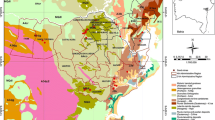Abstract
The most commonly recognized sources of sand and gravel aggregate are the deposits of coastal, fluvial and glacial sedimentary processes. It is not commonly recognized that weathered bedrock is also an important source of sand and gravel aggregate. In the case of weathered sedimentary bedrock the product may be indistinguishable from modern sedimentary materials and deposits may be misidentified. Batson's quarry is a major sand and gravel aggregate resource for the rapidly developing region of north-eastern New South Wales. The deposit has previously been assumed to be a young sedimentary deposit, but detailed field examination and comparison with surrounding rock types indicates that it has formed from weathered Mesozoic sandstone bedrock. The extraction of weathered bedrock aggregate deposits has distinctive environmental implications because, unlike sedimentary aggregates, they are not restricted by the geometry of sedimentary environments and do not necessarily interfere with surface drainage systems. This study shows that the recognition of the geological origin of a resource is essential in order to determine its potential geographical extent, and thereby maximize its utilization and minimize land use conflict.
Similar content being viewed by others
Author information
Authors and Affiliations
Additional information
Received: 3 January 1996 / Accepted: 1 November 1996
Rights and permissions
About this article
Cite this article
Stubbs, B., Smith, J. Weathered bedrock as a source of sand and gravel aggregate in north-eastern New South Wales, Australia. Environmental Geology 32, 64–70 (1997). https://doi.org/10.1007/s002540050194
Issue Date:
DOI: https://doi.org/10.1007/s002540050194




